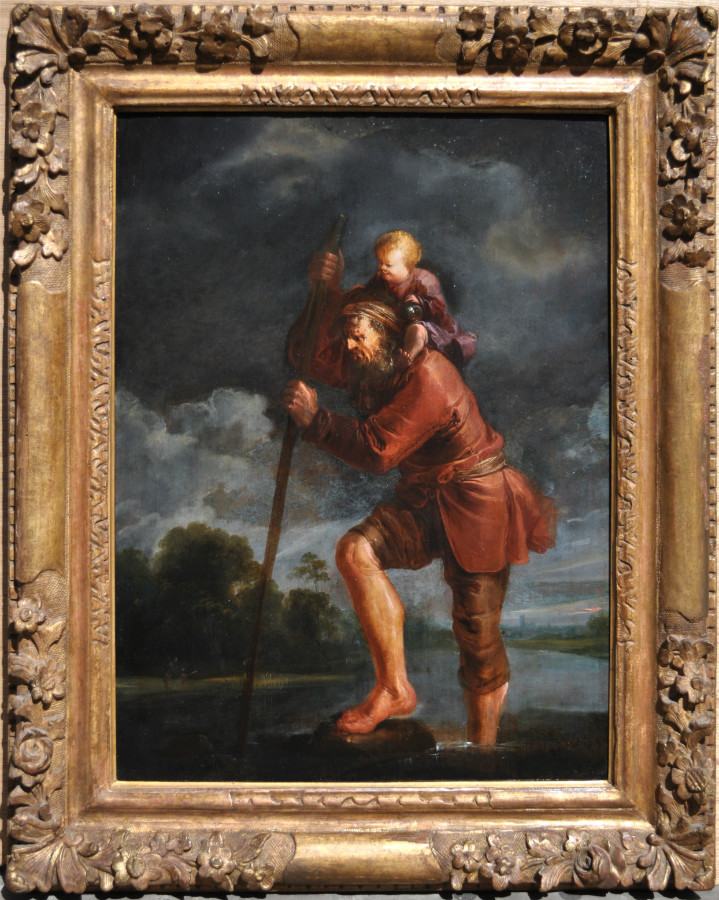Saint Christopher carrying the Christ Child
Oil on panel : 73,1 X 52,9 cm
Unsigned
Frame : 93,1 X 74,0 cm
"All paintings are fully documented with texts and photographs of comparative items. All this information is removed from our website once the painting is sold".

About Jan van de Venne
Flemish painter
Mechelen (?) circa 1592 – before 1651 Brussels (?)
Ancient sources sometimes spell his name as ‘van der Vinnen’.
Also known as the ‘Pseudo-Van de Venne’, because he used to be wrongly thought of as the brother of the better known Dutch painter Adriaen van de Venne. Jacques Foucart from the Louvre rectified this error in an article published in 1978.
Very few of his paintings are signed, but based on the signed or documented works it was very easy to attribute the unsigned ones, seeing the very specific style, subjects, use of light and brilliancy of Jan van de Venne.
Painter of genre scenes and also of religious subjects.
In 1616 he is recorded as a Master in the Painter’s Guild of Saint Luc in Brussels.
Van de Venne had important patrons, amongst them the Cardinal Infant Ferdinand and Archduke Leopold Wilhelm.
Van de Venne specialised in caricatured, so-called ‘low-life’ subjects, such as card-players, tooth-pullers and musicians, and in expressive religious scenes.
Because he regularly painted gipsies he is also known as ‘le Maître des Tziganes’ in France, where many museums hold his paintings (Aix-en Provence, Auxerre, Besançon, Chambéry, Dijon, Dunkirk, Hazebrouck, Lille, Marseille, Paris-Louvre, Quimper and Semur-en-Auxois).
His love for brownish tonalities and the choice of his themes are related to contemporary (Dutch) painters as Adriaen Brouwer and Adriaen van Ostade, or Benjamin Cuyp and Andries Both.
Van de Venne’s nervous style might have been influenced by David Teniers I; some authors even mention our painter must have studied under him.
About Saint Christopher
Saint Christopher was a Christian martyr who died in the third or early fourth century.
This very tall man with a fearsome face wanted “to serve the greatest king there was”.
First he served the King of Canaan, but left him to look for the devil, as the king was afraid of the devil. He joined a group of bandits, whose leader said he was the devil. When he heard the devil was afraid of Christ he looked for Christ.
A hermit told him that seeing his size and strength he could serve Christ by assisting people to cross a dangerous river. One day a small child asked Christopher to be carried to the other side. With each step the child became heavier and our giant barely made it.
When he finally reached the other side, he said to the child: “You have put me in the greatest danger. I do not think the whole world could have been as heavy on my shoulders as you were.” The child replied: “You had on your shoulders not only the whole world but Him who made it. I am Christ your king, whom you are by this work.” The child then vanished.
Saint Christopher was later decapitated by the king of the city of Lycia for he had converted many people in that pagan town.
Christopher means “he who carries Christ”.
Why should you buy this painting?
Because it is such a nice and tender scene, a classic subject of our religious painting, by a very interesting painter.
Because it has such a beautiful, wooden sculpted frame.
